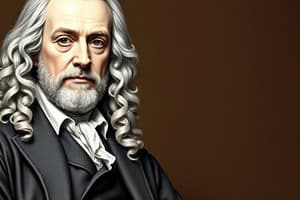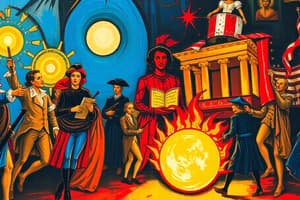Podcast
Questions and Answers
What was the main objective of the Proclamation Line of 1763?
What was the main objective of the Proclamation Line of 1763?
- To limit colonial expansion beyond the Appalachian Mountains. (correct)
- To facilitate trade with Native American tribes.
- To establish new colonies in Canada.
- To promote westward expansion for settlers.
Which compromise addressed the representation of enslaved individuals in determining a state's population?
Which compromise addressed the representation of enslaved individuals in determining a state's population?
- The Virginia Plan.
- The 3/5 Compromise. (correct)
- The Great Compromise.
- The New Jersey Plan.
What was a key difference between Anti-federalists and Federalists?
What was a key difference between Anti-federalists and Federalists?
- Federalists opposed the inclusion of the Bill of Rights. (correct)
- Anti-federalists supported a strong central government.
- Federalists favored state over federal power.
- Anti-federalists advocated for stronger individual liberties.
Which of the following was a consequence of Shay's Rebellion?
Which of the following was a consequence of Shay's Rebellion?
What was the significance of Thomas Paine's 'Common Sense'?
What was the significance of Thomas Paine's 'Common Sense'?
What was the primary purpose of the Bill of Rights when added to the Constitution?
What was the primary purpose of the Bill of Rights when added to the Constitution?
Which plan proposed at the Constitutional Convention aimed to create a bicameral legislature based on state population?
Which plan proposed at the Constitutional Convention aimed to create a bicameral legislature based on state population?
Which diplomatic policy is characterized by a more aggressive approach to foreign relations, particularly during Theodore Roosevelt's presidency?
Which diplomatic policy is characterized by a more aggressive approach to foreign relations, particularly during Theodore Roosevelt's presidency?
What was one of the main arguments of the Anti-Federalists against the ratification of the Constitution?
What was one of the main arguments of the Anti-Federalists against the ratification of the Constitution?
Which of the following accurately describes the outcome of Shay's Rebellion?
Which of the following accurately describes the outcome of Shay's Rebellion?
Flashcards
Proclamation Line of 1763
Proclamation Line of 1763
A line drawn by the British government in 1763. This line prohibited colonists from settling west of the Appalachian Mountains in order to prevent conflict with Native Americans.
Stamp Act
Stamp Act
A 1765 tax imposed by the British government on all paper goods in the American colonies. Colonists protested the tax without representation in Parliament. It was repealed in 1766.
Common Sense
Common Sense
A pamphlet written by Thomas Paine arguing for American independence from Great Britain. It inspired colonists with its clear and concise language and its focus on natural rights and self-governance.
Declaration of Independence
Declaration of Independence
Signup and view all the flashcards
Checks and Balances
Checks and Balances
Signup and view all the flashcards
Anti-Imperialism
Anti-Imperialism
Signup and view all the flashcards
Big Stick Policy
Big Stick Policy
Signup and view all the flashcards
Dollar Diplomacy
Dollar Diplomacy
Signup and view all the flashcards
Moral Diplomacy
Moral Diplomacy
Signup and view all the flashcards
Open Door Policy
Open Door Policy
Signup and view all the flashcards
Study Notes
Enlightenment Thinkers
- Key figures and ideas influenced the American Revolution.
Proclamation Line of 1763
- Established a boundary prohibiting colonial settlement west of the Appalachian Mountains.
Stamp Act
- Imposed a tax on printed materials.
Thomas Paine and Common Sense
- Paine's pamphlet advocated for American independence.
Declaration of Independence
- Outlined grievances against British rule and expressed Enlightenment ideals.
Articles of Confederation
- Strengths: Established a weak central government, allowing states significant autonomy.
- Weaknesses: Lacks strong central government to deal with national issues, making it difficult to enforce laws effectively and levy taxes.
Virginia Plan
- Proposed a bicameral legislature based on population.
- Outcomes: A major influence in shaping the structure of the United States Congress.
New Jersey Plan
- Advocated for equal representation for each state in the legislature.
- Outcomes: Influenced the creation of the Senate.
The Great Compromise
- Established a bicameral legislature with proportional representation in the House of Representatives and equal representation in the Senate.
- Outcomes: Compromise resolved conflict between the Virginia and New Jersey Plans.
The 3/5 Compromise
- Counted enslaved people as three-fifths of a person for the purpose of representation.
- Outcomes: Contentious agreement addressed representation of enslaved people; political compromise that avoided addressing the central issue of slavery.
Constitution and Checks and Balances
- System distributes power to three branches: Legislative, Executive, and Judicial with each branch checking the power of others to prevent tyranny.
Bill of Rights
- Added to the Constitution to protect individual liberties against governmental infringement.
Shay's Rebellion
- Farmers' uprising protesting high taxes and foreclosures on debt.
- Showed weaknesses of the Articles of Confederation.
Anti-Federalists vs. Federalists
- Anti-Federalists: Feared a powerful central government, favored state power, and opposed ratification of the Constitution.
- Federalists: Supported a strong central government and advocated for ratification of the Constitution.
Strict vs. Loose Construction of the Constitution
- Strict Construction: Government should only exercise powers explicitly mentioned in the Constitution — more focused on limitations on government power.
- Loose Construction: Government should interpret the Constitution broadly and exercise implied powers not explicitly listed — more focused on implied powers.
Hamilton vs. Jefferson
- Key figures representing different visions for the United States. (Detailed chart analysis needed for full understanding)
Results of Territory Gain from War
- Consequences of westward expansion and acquisition of new territories.
Anti-Imperialism
- Opposition to expanding US influence and control over other territories.
Panama Canal
- Construction of a waterway connecting the Atlantic and Pacific Oceans.
Big Stick Policy
- US policy using military force to advance American interests internationally.
Dollar Diplomacy
- Use of economic power to advance American interests abroad.
Moral Diplomacy
- Use of American ideals to influence international relations—advocating for democracy and moral values.
Open Door Policy
- Principle that all countries should have equal access to trade and investment opportunities in China.
Studying That Suits You
Use AI to generate personalized quizzes and flashcards to suit your learning preferences.




